On November 2, I mentioned that I had seen the first of the season Hooded Merganser. It was a single bird (alone) and appeared to be a female. On Thursday (11/10) there were three mergs in the Wetlands, a male and two females. Yesterday (11/15) there were ten birds in the water.
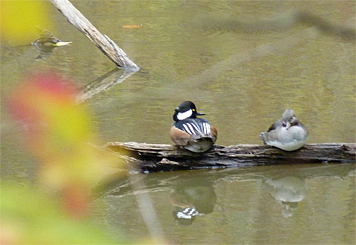
There was also a male Mallard in the Wetlands. There’s nothing unusual about a Mallard, but we don’t get many here in our Wetlands, at least not the way we used to. We often see a domestic x mallard pair, but not many “true” Mallards.
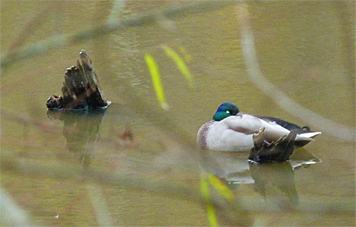
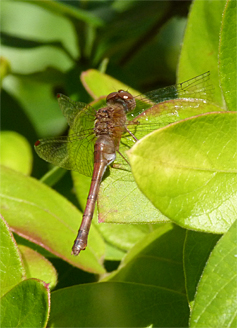
The insects?
On Tuesday (11/8) Animal Department Director, Sherry mentioned to me that she had just had a dragonfly land either on or next to her, I don’t remember which.
We were in Explore the Wild at the time and from the description given to me by Sherry it sounded as though she had seen an Autumn Meadowhawk (Sympetrum vicinum), one of only a few dragonflies likely to be seen at this time of year. I had seen a Common Green Darner the day before (probably a tardy migrant) but I hadn’t seen a meadowhawk to date. Autumn Meadowhawks are late season odes, I typically don’t see them until mid to late October and they can linger into December.
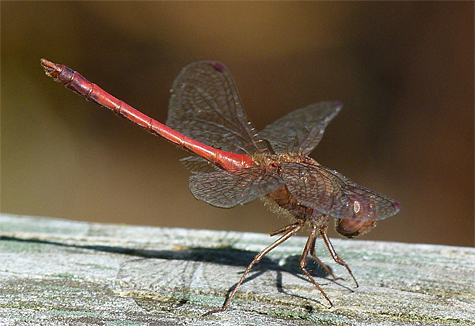
The second insect is, or was, a Locust Borer (Megacyllene robiniae). I say was because the insect is no more. I first saw the borer early in the day on Thursday (11/10) nectaring on Leather Leaf Viburnum, one of the only plants in bloom in Catch the Wind. With temps in the low 60s the insect was moving rather sluggishly as it nectared. I typically see these beetles when the goldenrod is in bloom, that has since gone by. They’re a good match for goldenrod, with their bright yellow markings on their head, pronotum, and elytra.
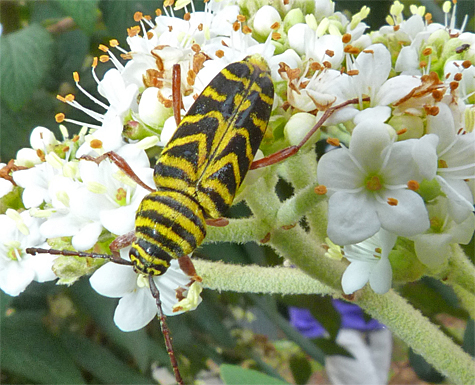
Each time that I walked by the viburnum that day (11/10) I stopped to see if the beetle was still present, it was. The beetle was on an umbel at eye level, very convenient for viewing. Sometime after noon, I was in the process of showing the beetle to some staff members (Teneka and Wendy) when I caught sight of a Wheel Bug (Arilus cristatus) on another of the viburnum’s flower umbels, higher up on the plant and not easily viewable.
I placed the wheel bug on the same flower umbel as the beetle for better viewing. This was a good move for us, the people observing the wheel bug, not so good for the beetle. Wheel Bugs are assassin bugs, they eat other insects.
I happened to be walking with Emily (rentals) several hours later through Catch the Wind. Excited to show Emily such a beautiful beetle as the Locust Borer, we approached the viburnum. I didn’t see the beetle on top of the flowers as I had earlier. The wheel bug was also absent. A closer look revealed their whereabouts. The wheel bug had ambushed the beetle and taken it under the flowers. The assassin had impaled the borer and was now sucking the insect dry.
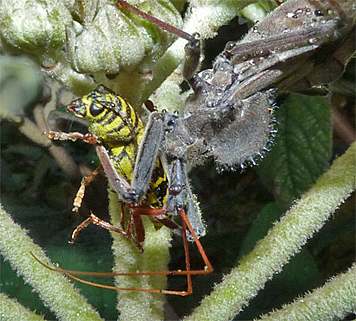
Wheel Bugs are looked upon by people as beneficial insects, preying on other so called harmful insects. Locust Borers are considered harmful insects since they bore into Black Locust Trees. I look at both of them as interesting insects in their own right. One of them (the wheel bug) lives by eating other insects, the other by eating wood (the beetle). I don’t particularly favor one over the other. I get excited when I come upon either which, as adults, is only in the fall of each year.
If I hadn’t have moved the Wheel Bug earlier in the day it probably would never have encountered the beetle. By placing the wheel bug on the same flower as the beetle I played a part in the beetle’s demise which, I must admit, I felt a twinge of guilt about.
You’re probably saying, “Come on Ranger Greg, they’re only a couple of insects. You’re being a bit too sentimental here.” Well, yeah, they are only a couple of insects, and insects are killed both intentionally and unintentionally by the millions, billions and more, each day. Collectors capture insects every day (especially beetles) to add to their collections, pesticides kill them every minute of every day, birds eat them by the truck load, so do frogs, toads, and lizards. Who knows how many are smashed on the windshields and grills of our vehicles every minute of every day everywhere in the world. That beetle…nothing to worry about.
In the grand scheme of things these two insects, the Wheel Bug and the beetle, are insignificant, there’s plenty more where they came from. And, both of these insects were destined to die within days, if not hours, of laying their eggs as happens each fall, the young hatching out the following spring. But I guess the point is (finally, the point), is that everything that we do in our daily lives somehow, no matter how small or insignificant it seems at the time, affects something or someone else in one way or another, for good or for bad.
Thanks for the reminder about the impact of our actions.
Good for the wheelbug, bad for the beetle. Good or bad for the Locust tree?
If this beetle hadn’t already laid eggs it’d be good for the tree, but I don’t know for sure whether it did lay eggs or not.
I know you didn’t ask me for this, but I can’t resist…They (the beetles) lay their eggs in cracks and crevices of the tree’s bark. The eggs hatch in a week and the larvae dig into the inner bark where they spend the winter. If a woodpecker or chickadee doesn’t get them, they bore into the trunk the following spring to feast on the tree’s wood, later emerging as adults around August, September, or even October. They then nectar on flowers (goldenrod is where I usually find them), all the while trying to avoid being eaten by predators such as Carolina Mantids or, well, Wheel Bugs. If successful in avoiding predators they then lay eggs into the cracks and crevices of the bark of a Black Locust Tree….